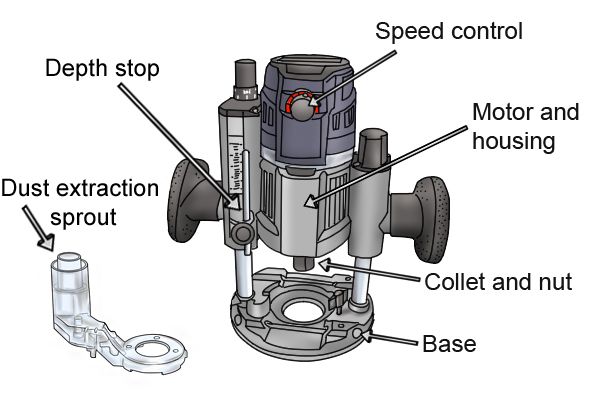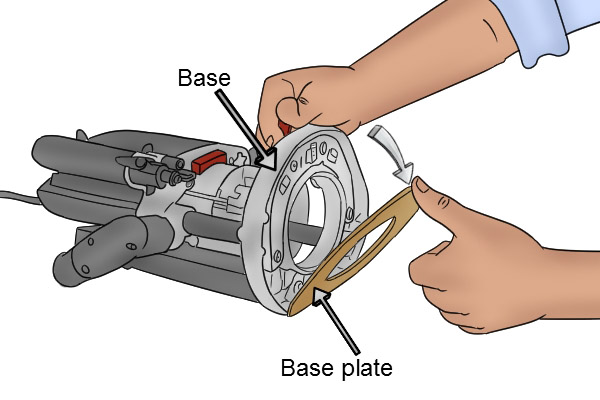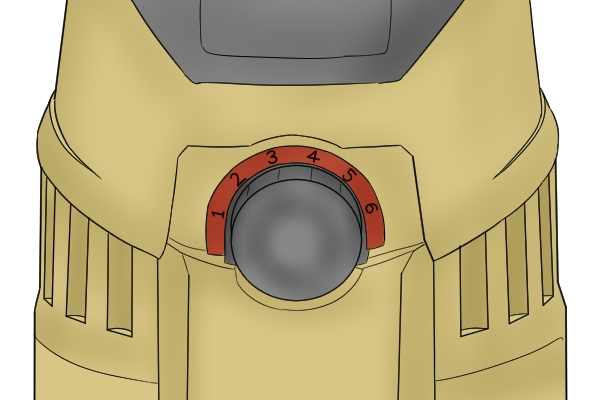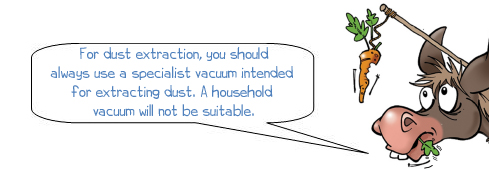What are the basic parts of routers? |
||||
 |
||||
 |
||||
 |
Individual routers may have different parts, and not all parts will be in exactly the same place, but most routers share these few basic parts and features. Manufacturer's instructions or specifications should include a detailed diagram of your particular machine which will show you exactly where all the parts are, and will often show how some of the parts are assembled. |
|||
Router motors |
||||
 |
Routers have a vertically mounted electric motor with a collet attached to the end of its spindle which is encased within the tool’s housing. The type of motor the router has will affect its power, and where it can be used. The voltage of the motor determines where it can be used. 230/240V motors are suitable for domestic and workshop uses, 110/115V motors can be used on building or work sites. The actual power input and output of the motor is displayed in watts. |
|||
 |
||||
Router collets |
||||
 |
The collet is essentially a steel sleeve positioned at the end of the motor’s spindle. It is enclosed within a locking (retaining) nut, that, when tightened, causes the collet to grip the shank-end of the router cutter or bit. It rotates when the router is running to spin the cutter so it can cut into the material. It will be sized according to the shank diameter of the cutters they can accept, so guiding you with what size of bits can be used. |
|||
Router bases |
||||
 |
The base is the bottom half of the router and has a hole in their centre through which the router cutter protrudes. On a plunge router, the base has two columns on which the router can be moved up or down. On a fixed base router, the base and top half of the router are connected, so there is no plunging movement. There is also a router sub-base, sometimes called a base plate, this is usually a flat disc which fits the bottom of the router base. |
|||
 |
The sub-base should protect the surface of the workpiece from being scratched by the router base, which is often made of metal. It also protects the base of your router from becoming damaged each time you set it down. You can also get other bases, and various accessories to fix to the base, which can be used to increase the number of applications the router can be used for, such as offset base plates, and combination bases. |
|||
Router speed controls |
||||
 |
The most versatile routers have a feature called variable speed control, which allows you to reduce the speed at which the router turns the cutter. This is handy if you want to use a variety of cutters, or bits, and you want to work with different materials. Without variable speed, you will be limited with what applications the router can be used for. Router speed is usually varied using a number dial, and there will often be a chart on the side of the router that tells you the speed to which the numbers are referring. |
|||
 |
The speed of the router is measured in rpm (rotations or revolutions per minute). It’s important to note that this number will usually refer to the no-load speed; the speed before a cutter or bit has been loaded. Once you load a cutter and begin work, the speed will drop depending on the size of the cutter, the hardness of the material you are cutting, and the depth of cut you're making. The specifications of an individual router will usually give you a minimum and maximum speed at which the router can turn a cutter. |
|||
Router depth stops |
||||
 |
The depth stop is used to set the height of the cutter, and therefore, the depth of the cut. This can then be locked into place so consistent depths can be cut each time. There will be a depth scale, which shows you the depth the cut will be in relation to the base. For plunging routers, it works as a guide to stop the router being lowered too far into the material. The instructions with your individual router will guide you on setting cut depths for specific models. |
|||
Dust extractor spout |
||||
 |
Good quality routers will come with something for assisting with dust extraction. This will usually be a dust extractor spout which will be designed to fit your individual model of router and is designed to be hooked up to a suitable dust extractor. Dust extraction is important as the way a router cuts will produce a large amount of fine dust. Various accessories are available to ensure the spout can be fitted to different dust extractors. These spouts should also be available as separate spare parts if needed, and dust extractor vacuums can be purchased separately. |
|||
 |
||||
 |
||||







